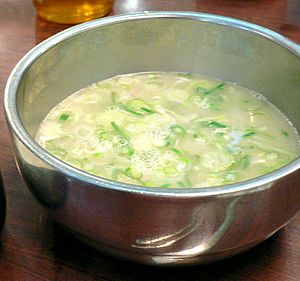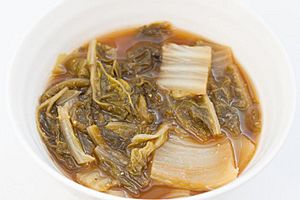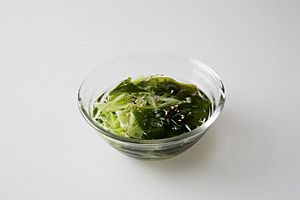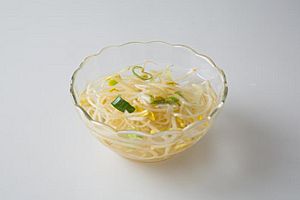Guk facts for kids
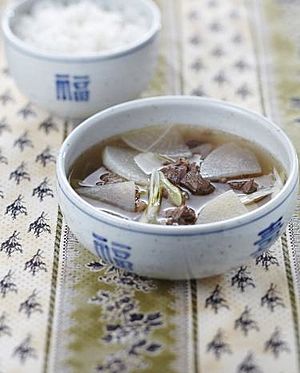
Soegogi-mu-guk (beef and radish soup)
|
|
| Alternative names | Tang |
|---|---|
| Type | Soup |
| Place of origin | Korea |
| Korean name | |
| Hangul |
국
|
|---|---|
| Revised Romanization | guk |
| McCune–Reischauer | kuk |
| IPA | [kuk̚] |
| Hangul |
탕
|
| Hanja |
湯
|
| Revised Romanization | tang |
| McCune–Reischauer | t'ang |
| IPA | [tʰaŋ] |
Guk (국) is a type of soup in Korean cuisine. It is also sometimes called tang (탕; 湯). Both guk and tang are very similar. Tang can sometimes be a bit thicker than guk.
Guk is a basic part of a Korean meal. It is served with bap (rice) and banchan (side dishes). When you set a Korean table, guk goes on the right side of the rice.
The word guk is a native Korean word. Tang comes from Chinese and originally meant "boiling water" or "soup." Tang is often used for more formal or thicker soups. For example, yeonpo-tang is octopus soup. Lighter soups with vegetables usually have -guk at the end of their name. Thicker soups with more solid ingredients are often called tang. For example, Gamja-guk (potato soup) and gamja-tang (pork back-bone stew) are different dishes.
Contents
Types of Korean Soups
Korean soups, or guk, are divided into four main types. These are malgeun jangguk, gomguk, tojangguk, and naengguk. Each type has its own special flavor and ingredients.
Malgeun Jangguk: Clear Soups
Malgeun jangguk means "clear soup seasoned with a condiment." These soups are usually clear and light. They are often seasoned with doenjang (soybean paste) or ganjang (soy sauce).
The main ingredients for these clear soups can be meat, fish, vegetables, or seafood. They are a common part of everyday Korean meals.
- Tteokguk (떡국), a soup made with tteok (rice cakes).
- Miyeok guk (미역국), a soup made with wakame (edible seaweed).
- Kongnamul guk (콩나물국), made with kongnamul (soybean sprouts).
- Muguk (무국), made with radish.
- Gamjaguk (감자국), made with potato.
- Jogaeguk (조개국), made with shellfish.
- Jaecheopguk (재첩국), a small clam soup from rivers in Gyeongsang-do.
Gomguk: Rich and Hearty Soups
Gomguk, also called gomtang, are rich and hearty soups. They are made by boiling different parts of beef, like ribs or oxtail, for a very long time. This long cooking makes the broth milky and full of flavor.
These soups can also be made with chicken or pork bones. For example, samgyetang is made with chicken, and gamjatang uses pork bone.
- Gomguk/gomtang (곰국/곰탕):
- Sagol gomtang (사골곰탕), pale bone broths with oxtail or brisket.
- Kkori gomtang (꼬리곰탕), ox tail soup.
- Seolleongtang (설렁탕): This ox leg bone soup is simmered for over 10 hours. It becomes milky-white and is often served with noodles and beef.
- Galbitang (갈비탕), made with galbi (beef ribs).
- Yukgaejang (육개장), a spicy beef soup with chili flakes and bean sprouts.
- Samgyetang (삼계탕), a chicken soup stuffed with ginseng and other healthy ingredients. It is often eaten in summer.
- Gamjatang (감자탕, "potato stew"), a spicy soup with pork spine, potatoes, and hot peppers. It's a popular snack or meal.
Tojangguk: Soybean Paste Soups
Tojangguk soups use doenjang (soybean paste) as their base. They also often use the water left over after washing rice. These soups have a deep, savory taste and are eaten all year round.
- Sigeumchi tojangguk (시금치토장국), made with spinach.
- Auk tojangguk (아욱토장국), made with malva leaves.
- Ugeojiguk (우거지국), made with ugeoji (dried napa cabbage leaves).
- Daseulgiguk (다슬기국), made with freshwater snails.
Naengguk: Cold Soups
Naengguk are cold soups, mostly eaten in the summer. They are also called changuk in pure Korean. The first mention of a cold soup in Korea was by a writer named Yi Gyu-bo from the Goryeo period (918–1392). He wrote about a clear and plain cold soup.
Cold soups are usually tangy and refreshing. Some are made with chilled water and vinegar for a sweet and sour taste. Others are richer and meant to give you energy in hot weather.
- Miyeok naengguk (미역냉국), cold wakame soup.
- Oi naengguk (오이냉국), cold cucumber soup.
- Kkaetguk (깻국), a hearty cold soup made with chicken and ground sesame seeds.
- Naengkongguk (냉콩국), made with ground soybeans. This can be used for kongguksu (cold soybean noodle soup).
- Kongnamul naengguk (콩나물냉국), made with kongnamul (soybean sprouts).
Other Popular Soups
Many other kinds of guk exist, using a variety of ingredients.
- Maeuntang (매운탕): A refreshing, hot, and spicy fish soup.
- Haejangguk (해장국): A hearty soup with pork spine, dried napa cabbage, and vegetables in beef broth.
- Haemultang (해물탕): Made with various seafood.
- Altang (알탕): Can be made with salted and fermented fish roe or fresh roe.
- Chueotang (추어탕): Made with Misgurnus mizolepis (a type of loach fish).
- Manduguk (만두국): Soup with mandu (Korean dumplings).
- Gyerantang (계란탕): Soup made with eggs.
- Sundaeguk (순댓국): Made with Sundae (Korean blood sausage). It sometimes includes other pork parts like liver or lungs.
Gukbap: Soup with Rice
Gukbap (국밥) means "soup with rice." These dishes developed from guk and are very popular. The rice is often served directly in the soup.
- Kongnamul gukbap (콩나물국밥), clear soybean sprout soup with rice.
- Gul-gukbap (굴국밥) – oyster and rice soup.
- Ttaro gukbap (따로국밥), a special kind of yukgaejang from Daegu.
Images for kids
See also
 In Spanish: Guk para niños
In Spanish: Guk para niños


